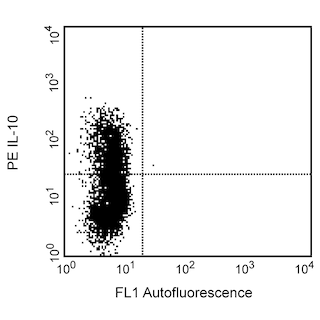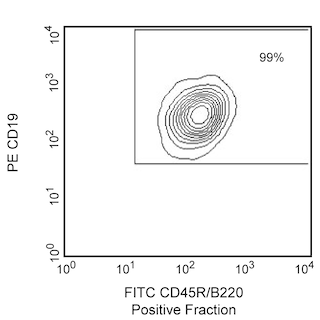Old Browser
This page has been recently translated and is available in French now.
Looks like you're visiting us from {countryName}.
Would you like to stay on the current country site or be switched to your country?


.png)

Flow cytometric analysis of CD365 (TIM-1) expression on activated mouse B cells. BALB/c mouse splenic B cells were isolated with BD IMag™ Anti-Mouse CD45R/B220 Magnetic Particles-DM (Cat. No. 551513) and cultured for 3 days in media alone (Left Panel) or stimulated (Right Panel) with AffiniPure F(ab')2 Goat Anti-Mouse Anti-IgM (Jackson ImmunoResearch) and Purified NA/LE Hamster Anti-Mouse CD40 antibody (Cat. No. 553721). The cells were harvested, preincubated with Purified Rat Anti-Mouse CD16/CD32 antibody (Mouse BD Fc Block™) (Cat. No. 553141/553142), and stained with either 0.25 μg of PE Rat IgG2b, κ Isotype Control (Cat. No. 556925; dashed line histograms) or PE Rat Anti-Mouse CD365 (TIM-1) antibody (Cat. No. 566335; solid line histograms). BD Via-Probe™ Cell Viability 7-AAD Solution (Cat. No. 555815/555816) was added to cells right before analysis. Histograms showing CD365 (TIM-1) expression were derived from 7-AAD-negative gated events with the forward and side light-scatter characteristics of viable lymphocytes. Flow cytometric analysis was performed using a BD LSRFortessa™ X-20 Flow Cytometer System. Data shown on this Technical Data Sheet are not lot specific.
.png)

BD Pharmingen™ PE Rat Anti-Mouse CD365 (TIM-1)
.png)
Regulatory Status Legend
Any use of products other than the permitted use without the express written authorization of Becton, Dickinson and Company is strictly prohibited.
Preparation And Storage
Product Notices
- An isotype control should be used at the same concentration as the antibody of interest.
- Since applications vary, each investigator should titrate the reagent to obtain optimal results.
- Caution: Sodium azide yields highly toxic hydrazoic acid under acidic conditions. Dilute azide compounds in running water before discarding to avoid accumulation of potentially explosive deposits in plumbing.
- For fluorochrome spectra and suitable instrument settings, please refer to our Multicolor Flow Cytometry web page at www.bdbiosciences.com/colors.
- Please refer to www.bdbiosciences.com/us/s/resources for technical protocols.
Companion Products






The RMT1-4 monoclonal antibody specifically recognizes CD365 which is encoded by Havcr1 (Hepatitis A virus cellular receptor 1) and commonly known as T cell immunoglobulin and mucin domain-containing protein 1 (TIM-1). TIM-1 is a type I transmembrane glycoprotein that contains an extracellular immunoglobulin V-like domain and mucin-like domain and a conserved intracellular tyrosine phosphorylation motif that is involved in transmembrane signaling. TIM-1 is a costimulatory molecule that plays an important role in regulating immune responses. It is expressed on mast cells, and activated T cells including T helper type 2 (Th2) cells. TIM-1 is constitutively expressed by some B cells with increased TIM-1 expression detected upon B cell activation. TIM-1 was reportedly expressed by the majority of IL-10-expressing regulatory B cells within several major splenic B cell subsets. These cells may play critical roles in Th2-like CD4 T cell differentiation and in the regulation of inflammation and autoimmunity. TIM-4, a phosphatidylserine receptor encoded by Timd4, is a putative ligand for TIM-1.

Development References (6)
-
Ding Q, Yeung M, Camirand G, et al. Regulatory B cells are identified by expression of TIM-1 and can be induced through TIM-1 ligation to promote tolerance in mice.. J Clin Invest. 2011; 121(9):3645-56. (Clone-specific: Flow cytometry). View Reference
-
Kuchroo VK, Umetsu DT, DeKruyff RH, Freeman GJ. The TIM gene family: emerging roles in immunity and disease.. Nat Rev Immunol. 2003; 3(6):454-62. (Biology). View Reference
-
Ma J, Usui Y, Takeda K, et al. TIM-1 signaling in B cells regulates antibody production.. Biochem Biophys Res Commun. 2011; 406(2):223-8. (Biology: Flow cytometry). View Reference
-
Meyers JH, Chakravarti S, Schlesinger D, et al. TIM-4 is the ligand for TIM-1, and the TIM-1-TIM-4 interaction regulates T cell proliferation.. Nat Immunol. 2005; 6(5):455-64. (Biology). View Reference
-
Nakae S, Iikura M, Suto H, et al. TIM-1 and TIM-3 enhancement of Th2 cytokine production by mast cells.. Blood. 2007; 110(7):2565-8. (Immunogen: Flow cytometry). View Reference
-
Umetsu SE, Lee WL, McIntire JJ, et al. TIM-1 induces T cell activation and inhibits the development of peripheral tolerance.. Nat Immunol. 2005; 6(5):447-54. (Biology). View Reference
Please refer to Support Documents for Quality Certificates
Global - Refer to manufacturer's instructions for use and related User Manuals and Technical data sheets before using this products as described
Comparisons, where applicable, are made against older BD Technology, manual methods or are general performance claims. Comparisons are not made against non-BD technologies, unless otherwise noted.
For Research Use Only. Not for use in diagnostic or therapeutic procedures.
Report a Site Issue
This form is intended to help us improve our website experience. For other support, please visit our Contact Us page.